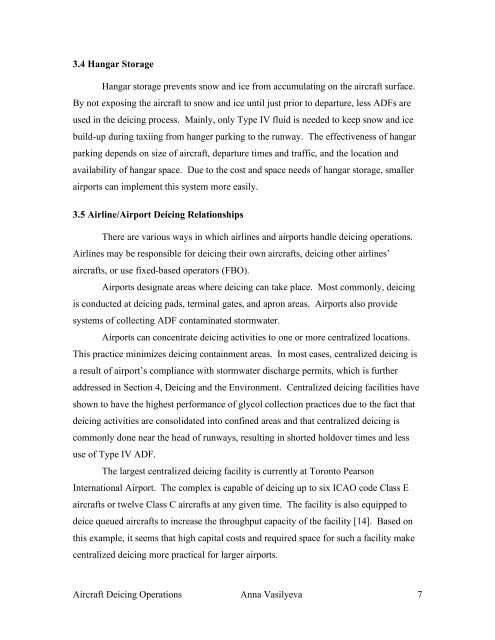Aircraft Deicing Operations
Aircraft Deicing Operations
Aircraft Deicing Operations
You also want an ePaper? Increase the reach of your titles
YUMPU automatically turns print PDFs into web optimized ePapers that Google loves.
3.4 Hangar StorageHangar storage prevents snow and ice from accumulating on the aircraft surface.By not exposing the aircraft to snow and ice until just prior to departure, less ADFs areused in the deicing process. Mainly, only Type IV fluid is needed to keep snow and icebuild-up during taxiing from hanger parking to the runway. The effectiveness of hangarparking depends on size of aircraft, departure times and traffic, and the location andavailability of hangar space. Due to the cost and space needs of hangar storage, smallerairports can implement this system more easily.3.5 Airline/Airport <strong>Deicing</strong> RelationshipsThere are various ways in which airlines and airports handle deicing operations.Airlines may be responsible for deicing their own aircrafts, deicing other airlines’aircrafts, or use fixed-based operators (FBO).Airports designate areas where deicing can take place. Most commonly, deicingis conducted at deicing pads, terminal gates, and apron areas. Airports also providesystems of collecting ADF contaminated stormwater.Airports can concentrate deicing activities to one or more centralized locations.This practice minimizes deicing containment areas. In most cases, centralized deicing isa result of airport’s compliance with stormwater discharge permits, which is furtheraddressed in Section 4, <strong>Deicing</strong> and the Environment. Centralized deicing facilities haveshown to have the highest performance of glycol collection practices due to the fact thatdeicing activities are consolidated into confined areas and that centralized deicing iscommonly done near the head of runways, resulting in shorted holdover times and lessuse of Type IV ADF.The largest centralized deicing facility is currently at Toronto PearsonInternational Airport. The complex is capable of deicing up to six ICAO code Class Eaircrafts or twelve Class C aircrafts at any given time. The facility is also equipped todeice queued aircrafts to increase the throughput capacity of the facility [14]. Based onthis example, it seems that high capital costs and required space for such a facility makecentralized deicing more practical for larger airports.<strong>Aircraft</strong> <strong>Deicing</strong> <strong>Operations</strong>.Anna Vasilyeva7
















